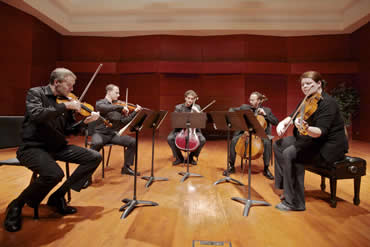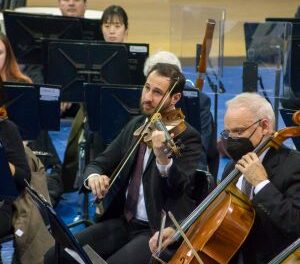As the Asheville Symphony Orchestra began tuning underneath the pavilion in Pack Square Park, led by their conductor Darko Butorac, it commemorated the first time in over 500 days that the orchestra prepared to play in front of a live audience. The excitement in the air was palpable as musicians crowded onto the stage and onlookers laid out blankets and picnics, preparing for what was most likely their first concert in months.
The program, including classical and pop delights alike, was incredibly well-balanced. With several surprise pieces and old crowd-pleasers, there was a selection for everyone to enjoy.
A preshow performance from the Asheville Symphony Youth Orchestra percussionists gave a few hints at what was to come. The young musicians performed enthusiastically, audibly pulsating the expectation of the crowd and orchestra alike.
The opening number was Rossini’s Overture to The Barber of Seville. Whilst Butorac led the orchestra bravely through this popular masterpiece, the dynamics were dull and unvaried – a disappointment for such a characteristic piece. Granted, the first pieces in any concert program certainly have some of the highest expectations. Thankfully, the performances only improved throughout the rest of the night.
Brahms’ Hungarian Dance No. 5, Allegro was a familiar delight, with Butorac reminding the audience of the beloved Bugs Bunny cartoon. The first surprise off program came as Agustín Bardi‘s (1884-1941) tango, “The Blind Rooster” (Gallo Ciego). Here, the articulations of the orchestra were featured beautifully, with a great balance between instrumental voices and some gorgeous solo lines for the first violinist. The only aspect missing was a couple dancing the tango!
A surprise crowd favorite comes as a selection from Aaron Copland’s (1900-90) Rodeo, a cowboy ballet in one act, divided into five sections. The final section, titled “Hoedown” features a perhaps familiar folk tune known as “Bonaparte’s Retreat”, first composed by fiddler William Hamilton Stepp. The orchestra played this piece masterfully, with great texture and balance between voices and crystal-clear piano lines that cut through the instruments. With Copland, the difficulty comes in texture and tone, simplistic elegance is a must. ASO approached Copland correctly and successfully.
Considering this concert took place in the United States of America, it would be remissive of the organizers of this program to not include Leonard Bernstein, arguably one of the greatest American musical figures. An arrangement of selections from West Side Story was a fantastic choice considering the parallels in modern life. West Side Story is a true American melting pot musical, with various cultural influences, rhythms, melodies, and styles. It’s a story of overcoming differences, something everyone needs currently. Butorac directed the ASO exceptionally well in this piece, with clear direction and articulations, as well as seamlessly weaving through the different styles and difficulties that West Side Story proposes.
Following intermission, the audience was introduced to the guest star of the evening, Michael Preacely, an American baritone on the rise in the operatic scene. Preacely has performed with various American operas in roles ranging from the Phantom in Andrew Llyod Weber’s Phantom of the Opera to Porgy in George Gershwin’s Porgy and Bess. The extremely charismatic Preacely warmed up the audience with a Gershwin classic, “They Can’t Take that Away from Me” and Rogers and Hammerstein’s “Some Enchanted Evening” from South Pacific. The orchestra was well-balanced against Preacely’s rich timbre, and the chemistry between Butorac and Preacely was professional and effective.
Although Preacely’s best performance came as Cab Calloway’s “Minnie the Moocher.” Whilst the name may not be familiar, the voice and melodies of Calloway are. From the cartoon Betty Boop to the 1980 film The Blues Brothers, “Minnie the Moocher” is a beloved classic, even being inducted into the Grammy Hall of Fame in 1999. It’s argued the tune gave Calloway the honor of being the first African-American to sell over a million record copies. The piece requires audience participation with a scatting call-and-response section, which Preacely performed well. His scatting was difficult enough to keep the audience’s interest, but not so outrageous that the crowd couldn’t sing along.
After Preacely’s performances, the last highlight was the climax of the program, the “End Title” from Star Wars: Episode IV by John Williams. When playing popular and familiar pieces such as this, it’s the tendency of the orchestra to not follow the conductor, and instead follow their own tempo and dynamic changes. However, Butorac and the ASO were in allignment, following the other with acceptable give and take. After a rousing standing ovation, and a demanded encore, Butorac led the orchestra in Queen’s “We Are the Champions”. The audience sang along to the classic rock hit, followed by another standing ovation.
After months and months of cancelled concerts, virtual performances, and delayed events, any in-person concert is refreshing in ways that words can’t describe. The ASO gave a warm and welcoming return to concertizing. With several exciting performances scheduled, the ASO is in for an exciting and long-awaited concert season.












